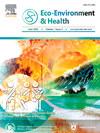Adverse outcome pathway for the neurotoxicity of Per- and polyfluoroalkyl substances: A systematic review
IF 17.6
引用次数: 0
Abstract
Per- and polyfluoroalkyl substances (PFAS) are endocrine disruptors with unambiguous neurotoxic effects. However, due to variability in experimental models, population characteristics, and molecular endpoints, the elucidation of mechanisms underlying PFAS-induced neurotoxicity remains incomplete. In this review, we utilized the adverse outcome pathway (AOP) framework, a comprehensive tool for evaluating toxicity across multiple biological levels (molecular, cellular, tissue and organ, individual, and population), to elucidate the mechanisms of neurotoxicity induced by PFAS. Based on 271 studies, the reactive oxygen species (ROS) generation emerged as the molecular initiating event 1 (MIE1). Subsequent key events (KEs) at the cellular level include oxidative stress, neuroinflammation, apoptosis, altered Ca2+ signal transduction, glutamate and dopamine signaling dyshomeostasis, and reduction of cholinergic and serotonin. These KEs culminate in synaptic dysfunction at organ and tissue levels. Further insights were offered into MIE2 and upstream KEs associated with altered thyroid hormone levels, contributing to synaptic dysfunction and hypomyelination at the organ and tissue levels. The inhibition of Na+/I− symporter (NIS) was identified as the MIE2, initiating a cascade of KEs at the cellular level, including altered thyroid hormone synthesis, thyroid hormone transporters, thyroid hormone metabolism, and binding with thyroid hormone receptors. All KEs ultimately result in adverse outcomes (AOs), including cognition and memory impairment, autism spectrum disorders, attention deficit hyperactivity disorders, and neuromotor development impairment. To our knowledge, this review represents the first comprehensive and systematic AOP analysis delineating the intricate mechanisms responsible for PFAS-induced neurotoxic effects, providing valuable insights for risk assessments and mitigation strategies against PFAS-related health hazards.

全氟和多氟烷基物质神经毒性的不良后果途径:系统综述
全氟烷基和多氟烷基物质(PFAS)是一种内分泌干扰物,具有明确的神经毒性作用。然而,由于实验模型、人群特征和分子终点的差异,对全氟辛烷磺酸诱导神经毒性机制的阐明仍不完整。在本综述中,我们采用了不良后果途径(AOP)框架来阐明全氟辛烷磺酸诱导神经毒性的机制。该框架是一种评估多个生物水平(分子、细胞、组织和器官、个体和人群)毒性的综合工具。在 271 项研究的基础上,活性氧 (ROS) 的生成成为分子起始事件 1 (MIE1)。细胞水平的后续关键事件(KEs)包括氧化应激、神经炎症、细胞凋亡、Ca2+ 信号转导改变、谷氨酸和多巴胺信号失衡以及胆碱能和血清素减少。这些 KEs 最终导致器官和组织水平的突触功能障碍。研究还进一步揭示了与甲状腺激素水平改变相关的MIE2和上游KEs,这些KEs在器官和组织水平上导致了突触功能障碍和髓鞘功能减退。Na+/I-交感器(NIS)的抑制被确定为MIE2,它在细胞水平启动了一连串的KEs,包括甲状腺激素合成、甲状腺激素转运体、甲状腺激素代谢以及与甲状腺激素受体结合的改变。所有KEs最终都会导致不良后果(AOs),包括认知和记忆障碍、自闭症谱系障碍、注意缺陷多动障碍和神经运动发育障碍。据我们所知,本综述是首次对 AOP 进行全面、系统的分析,描述了全氟辛烷磺酸诱发神经毒性效应的复杂机制,为针对全氟辛烷磺酸相关健康危害的风险评估和缓解策略提供了宝贵的见解。
本文章由计算机程序翻译,如有差异,请以英文原文为准。
求助全文
约1分钟内获得全文
求助全文
来源期刊

Eco-Environment & Health
环境科学与生态学-生态、环境与健康
CiteScore
11.00
自引率
0.00%
发文量
18
审稿时长
22 days
期刊介绍:
Eco-Environment & Health (EEH) is an international and multidisciplinary peer-reviewed journal designed for publications on the frontiers of the ecology, environment and health as well as their related disciplines. EEH focuses on the concept of “One Health” to promote green and sustainable development, dealing with the interactions among ecology, environment and health, and the underlying mechanisms and interventions. Our mission is to be one of the most important flagship journals in the field of environmental health.
Scopes
EEH covers a variety of research areas, including but not limited to ecology and biodiversity conservation, environmental behaviors and bioprocesses of emerging contaminants, human exposure and health effects, and evaluation, management and regulation of environmental risks. The key topics of EEH include:
1) Ecology and Biodiversity Conservation
Biodiversity
Ecological restoration
Ecological safety
Protected area
2) Environmental and Biological Fate of Emerging Contaminants
Environmental behaviors
Environmental processes
Environmental microbiology
3) Human Exposure and Health Effects
Environmental toxicology
Environmental epidemiology
Environmental health risk
Food safety
4) Evaluation, Management and Regulation of Environmental Risks
Chemical safety
Environmental policy
Health policy
Health economics
Environmental remediation
 求助内容:
求助内容: 应助结果提醒方式:
应助结果提醒方式:


